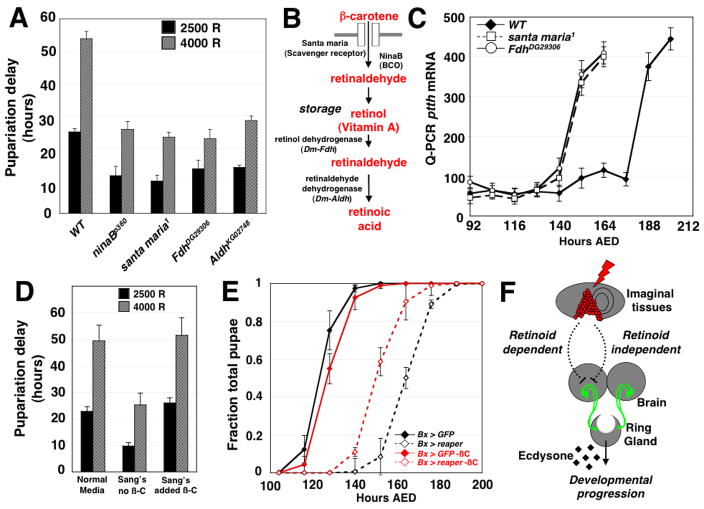Figure 4.
Retinoid metabolism regulates checkpoint-induced delay in irradiated larvae. (A) Pupariation delay in wild-type larvae or homozygous mutant larvae carrying mutations in genes required for retinoid metabolism. n=3 independent populations were assayed for all timing experiments with all mutants unless otherwise noted. p < 0.01 for each pairwise comparison of wild-type and mutant pupariation delay for all four mutants irradiated at 2500 and 4000 rad, as calculated by two-tailed Student’s t-test. (B) A schematic illustrating retinoid metabolic pathways and the gene products required for each step of retinoid metabolism. The genes responsible for retinol dehydrogenase and retinaldehyde dehydrogenase activities in Drosophila have not been identified. Sequence comparisons suggest that the most similar Drosophila gene to vertebrate retinol dehydrogenase is the Drosophila Formaldehyde dehydrogenase (Fdh) gene; the most similar Drosophila gene to vertebrate retinaldehyde dehydrogenase is the Aldehyde dehydrogenase (Aldh) gene of Drosophila. (C) ptth transcript levels in X-irradiated (4000 R), wild type, FdhDG29306 and santa maria1 larvae. ptth transcript was detected using quantitative RT-PCR. (D) Pupariation delay in irradiated wild-type larvae raised either on normal molasses-cornmeal food, or Sang’s defined medium that is either missing (−A) or supplemented with (+A) β-carotene. p < 0.01 in a pairwise comparison of delay in Normal vs. Sang’s (−A) medium at both at 2500 and 4000 rad. The timing of n=3 independent populations were assayed for each condition. p < 0.01 in a pairwise comparison of delay in Sang’s (−A) vs. Sang’s (+A) medium at both at 2500 and 4000 rad; both p-values were calculated by two-tailed Student’s t-test. (E) Developmental timing of Bx > GFP and Bx > rpr larvae raised on carotenoid-deficient Sang’s defined medium (red) or Sang’s defined medium supplemented with 1.25 g/L β-carotene (black). Bx > rpr larvae grown on carotenoid-deficient Sang’s medium exhibit a shorter larval duration than siblings grown on β-carotene supplemented medium. The timing of n=4 independent populations were assayed for each genetic background under each condition. (F) A model for the developmental checkpoint for tissue repair. Damage to imaginal discs is capable of regulating the expression of the ptth gene in the PTTH-expressing neurons via both a retinoid-dependent pathway, defined by the retinoid biosynthesis mutant phenotypes described in this work, and a second, retinoid-independent pathway.

